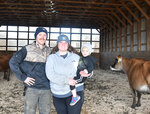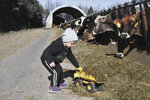

HAYFIELD, Minn. — On a morning late in May 2022, a semi-trailer, three trucks with cattle trailers and personal vehicles left a farm near Dodgeville, Wisconsin, and drove to a new farm in Minnesota.
“I wish I would have gotten more pictures of it,” Katie Fancsali said. “The whole caravan … everything in our whole lives (was) right there.”
Bradley and Katie Fancsali and their son, Buckley, own and operate a 100-cow dairy farm near Hayfield. They purchased the farm, house, land and a herd of dairy cows from Daryn McGowan in 2022.
Neither Bradley or Katie grew up on a dairy farm. Bradley was introduced to the dairy industry by a dairy farmer who babysat him. Katie milked a cow for the first time at about the age of 16.
The young couple has experienced many naysayers in their dairy-farming journey.
“Everybody’s going to tell you that there are no opportunities in dairy, (that) it’s not a smart thing to get into,” Katie said.
Bradley agreed.
“We’ve had a lot of people who told us that we couldn’t do it,” he said.
Among the people who were negative were dairy farmers. Katie said it is unfortunate that people have this perspective.
“It’s a hard life; it’s not easy,” she said. “It’s a lot of work, but it’s a good life.”
Bradley, who was in the U.S. Marine Corps Reserve from 2012-19, started working on dairy farms in 2013 as soon as he completed basic training and even worked on two research farms.
The couple met in 2019 when Bradley was working as a herdsman at a dairy near Zumbro Falls and Katie was a sales representative for ABS Global. They married in 2020 and had Buckley in 2021.
After working together on various dairy farms, the Fancsalis finally came to a dairy farm near Dodgeville, Wisconsin, where they were in charge of the dairy herd for two years. However, buying or renting that farm for themselves was not an option, and the Fancsalis’ goal was to eventually work for themselves.
The Fancsalis began looking for a farm near to either Bradley’s parents in Wisconsin or Katie’s parents in Minnesota.
In early winter of 2022, Daryn McGowan, a former classmate of Katie’s mom, reached out to Katie’s dad with the news his farm was going to be for sale.
By March, the Fancsalis had agreed to move to the farm and had begun the process of getting financed through the bank and the U.S. Department of Agriculture’s Farm Service Agency.
Katie’s parents looked at the farm for them since they were about three hours away.
“They (said), ‘It’s got good bones; it’s a good place to start,’” Katie said.
Bradley said he did not see the farm until about two weeks before they moved there.
In late May, after having fulfilled their 60-day notice with the farm in Dodgeville, they moved their 30 head of cattle and a crateful of barn cats to their new home.
When the Fancsalis arrived, they did not own the farm and their FSA loan had yet to be approved.
“Sometimes you have to just jump off the cliff,” Bradley said.
The loan was approved by July.
“We really came here on a wing and a prayer (and thinking), ‘Fingers crossed. I hope this works,’” Katie said.
They worked with McGowan for the next two milkings to learn the farm and setup.
It was a stressful time. Bradley said he had a migraine for about a week — and he does not usually get migraines.
The Fancsalis said, if they were visiting with someone else preparing to go through a similar transition, they would tell them to build in more time with the past owner to learn the setup, unlike they had done with their transition.
“If you’re buying from a specific person, ask that person everything that you can think of,” Katie said. “(The previous owner) ran that farm successfully for years. They’re going to be your best resource.”
Initially, the Fancsalis lived with Katie’s parents for about a month. McGowan moved to his new home about a week after they arrived. The house was sold as is, so the Fancsalis spent several weeks making interior updates to the home and completing other tasks before moving in.
The farm had previously been a seasonal, rotationally grazed farm. The Fancsalis decided to go away from seasonal milking and to start feeding a total mixed ration.
The last of the Fancsalis’ spring 2022 calving cows will calve in this December after being switched from seasonal. Bradley said the cows are transitioning and that it seemed to be most difficult for the mid-aged cows to adjust versus the young cows and the old cows.
The Fancsalis have taken out most of the pasture and put them into fields. The farm is about 120 acres, 100 of which is tillable. They also were able to take over the farm’s land leases, which gives them another 110 acres of land.
The couple practices no till and plants cover crops. They rely on cover crops for more feed, and these practices help with soil health and prevent erosion. In their rotation, they have corn, sorghum-sudan and alfalfa as well as cover crops which mostly consist of rye but include cover crop mixes.
Production-wise, Bradley hopes to get the herd average to 65 pounds a day within the next five years. He also wants to increase the herd’s milk components.
The herd is mostly Jersey, Brown Swiss, Holstein and Red & White. Their components are 5.1% butterfat and 3.7% protein. Bradley would like to average between 5.6% and 6% butterfat. He said the herd has reached 5.6% before. For protein, Bradley would like to be at or above 4%. The herd has reached 4% before.
In the far future, the Fancsalis would like to put up new buildings such as a freestall barn, a milking area and a house. Today, after already having come so far, the Fancsalis said they are thankful for all who have helped them on their journey.
Comments
No comments on this item Please log in to comment by clicking here